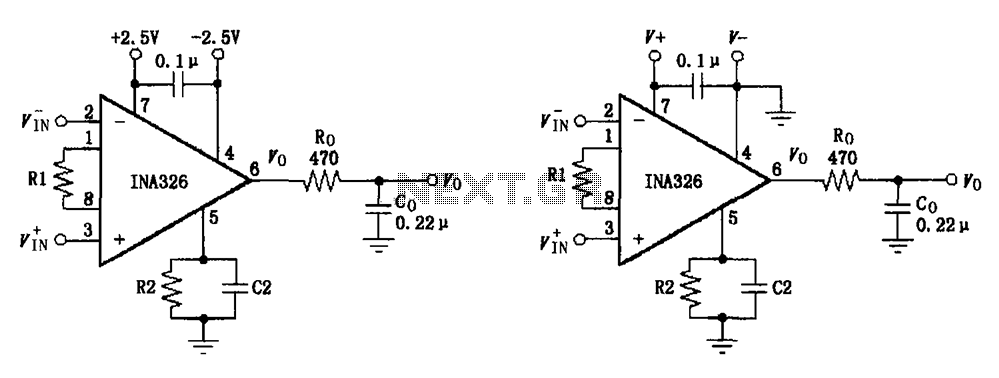
Combining the Composite Sync to the Green Signal
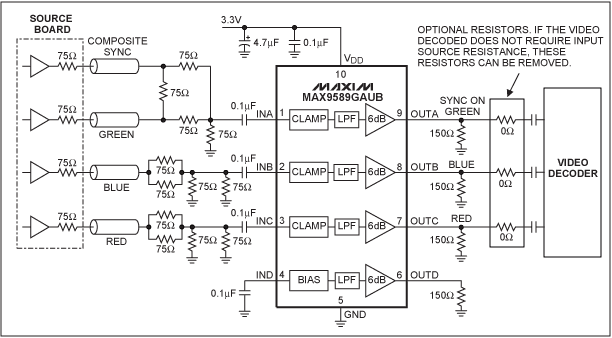
In certain video applications, signal sources provide RGB signals along with a composite sync signal. The RGB signals do not include video sync. On the receiving end, some budget video decoders lack a separate composite sync input; they only accept the sync signal integrated with the video signal. To address this, a "sync on green" circuit is required, which integrates the sync signal onto the green channel. A simple and cost-effective solution exists to combine the composite sync with the green channel for standard-definition video. The circuit depicted in Figure 1 utilizes the MAX9589 to merge the composite sync into the green channel while generating standard RGB signals at each output. For instance, consider a 0.7V peak-to-peak green signal input and a 0.3V composite sync signal input from video sources with 75-ohm terminations. According to Figure 1, the output signal at the green channel after processing through the MAX9589 is 1V peak-to-peak. The output signals for the 0.7V peak-to-peak red and blue input signals from the source remain at 0.7V peak-to-peak after passing through the MAX9589. An advantage of using the MAX9589 in this application is its capability to function as an anti-aliasing filter prior to the video decoder, thereby enhancing video performance.
The described circuit effectively addresses the integration of composite sync signals with RGB signals in video applications where low-cost decoders are used. The MAX9589, a high-speed video amplifier, plays a crucial role in this process. It not only combines the sync signal with the green channel but also ensures that the output maintains the integrity of the RGB signals. The circuit operates by accepting the RGB inputs and the composite sync signal and processing them to produce a synchronized output suitable for the video decoder.
The implementation involves connecting the green channel input and the composite sync input to the MAX9589. The device's internal architecture allows for the addition of the sync signal to the green channel without distorting the original RGB signals. The output from the MAX9589 is then fed into the video decoder, which can interpret the combined signal correctly.
This configuration is particularly advantageous in applications where space and cost are constraints, as it minimizes the need for additional components while enhancing performance. The anti-aliasing filtering capability of the MAX9589 is particularly beneficial, as it reduces potential artifacts in the video signal, leading to clearer and more stable image quality. This feature is essential in maintaining high video fidelity, especially in standard-definition applications where signal integrity is paramount.In some video applications, the signal sources deliver RGB signals and a composite sync signal. The RGB signals contain no video sync. At the receiver side, some low-cost video decoders do not have a stand-alone composite sync input; they only accept the sync signal with the video signal. Adding the sync signal onto the green channel for such an a pplication requires a "sync on green" circuit. There is a simple, low-cost way to add the composite sync onto the green channel for standard-definition video. The circuit in Figure 1 uses the MAX9589 to add the composite sync to the green channel, and generates the standard RGB signals at each output.
For example, consider a 0. 7VP-P green signal input and a 0. 3V composite SYNC signal input from the video sources that have 75 © terminations. From Figure 1 the output signal at the green channel after the MAX9589 is 1VP-P. For the 0. 7VP-P R and B input signals from the source, the output signals after the MAX9589 are 0. 7VP-P. There is an advantage to using the MAX9589 in this application. The MAX9589 can be used as an anti-aliasing filter in front of the video decoder and, thus, improves the video performance. 🔗 External reference
The described circuit effectively addresses the integration of composite sync signals with RGB signals in video applications where low-cost decoders are used. The MAX9589, a high-speed video amplifier, plays a crucial role in this process. It not only combines the sync signal with the green channel but also ensures that the output maintains the integrity of the RGB signals. The circuit operates by accepting the RGB inputs and the composite sync signal and processing them to produce a synchronized output suitable for the video decoder.
The implementation involves connecting the green channel input and the composite sync input to the MAX9589. The device's internal architecture allows for the addition of the sync signal to the green channel without distorting the original RGB signals. The output from the MAX9589 is then fed into the video decoder, which can interpret the combined signal correctly.
This configuration is particularly advantageous in applications where space and cost are constraints, as it minimizes the need for additional components while enhancing performance. The anti-aliasing filtering capability of the MAX9589 is particularly beneficial, as it reduces potential artifacts in the video signal, leading to clearer and more stable image quality. This feature is essential in maintaining high video fidelity, especially in standard-definition applications where signal integrity is paramount.In some video applications, the signal sources deliver RGB signals and a composite sync signal. The RGB signals contain no video sync. At the receiver side, some low-cost video decoders do not have a stand-alone composite sync input; they only accept the sync signal with the video signal. Adding the sync signal onto the green channel for such an a pplication requires a "sync on green" circuit. There is a simple, low-cost way to add the composite sync onto the green channel for standard-definition video. The circuit in Figure 1 uses the MAX9589 to add the composite sync to the green channel, and generates the standard RGB signals at each output.
For example, consider a 0. 7VP-P green signal input and a 0. 3V composite SYNC signal input from the video sources that have 75 © terminations. From Figure 1 the output signal at the green channel after the MAX9589 is 1VP-P. For the 0. 7VP-P R and B input signals from the source, the output signals after the MAX9589 are 0. 7VP-P. There is an advantage to using the MAX9589 in this application. The MAX9589 can be used as an anti-aliasing filter in front of the video decoder and, thus, improves the video performance. 🔗 External reference
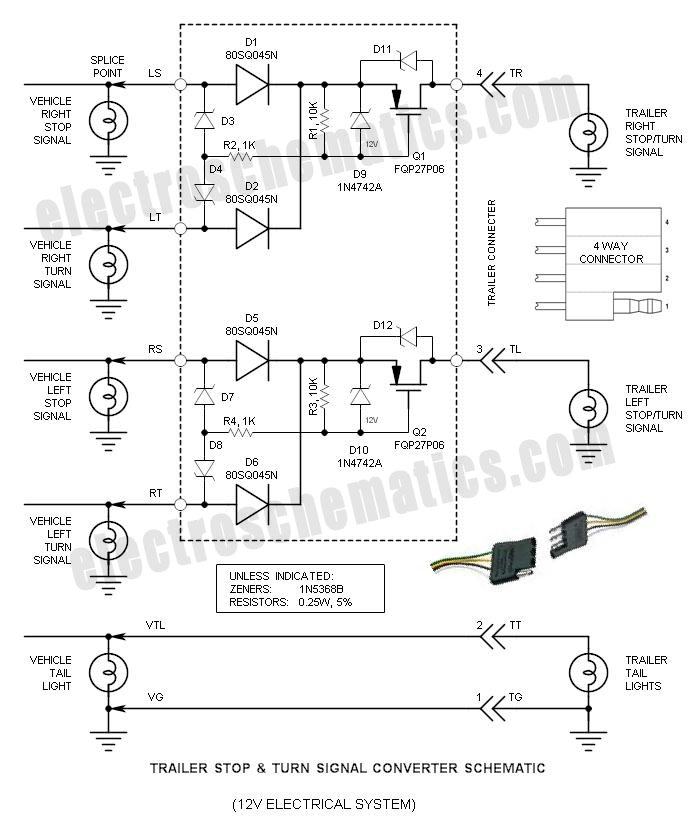
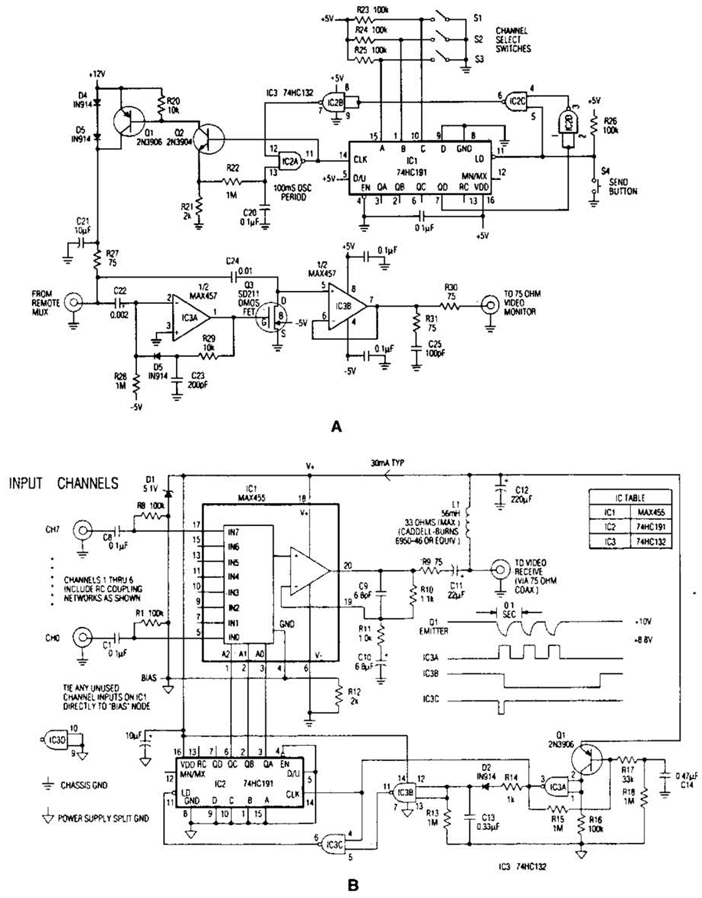
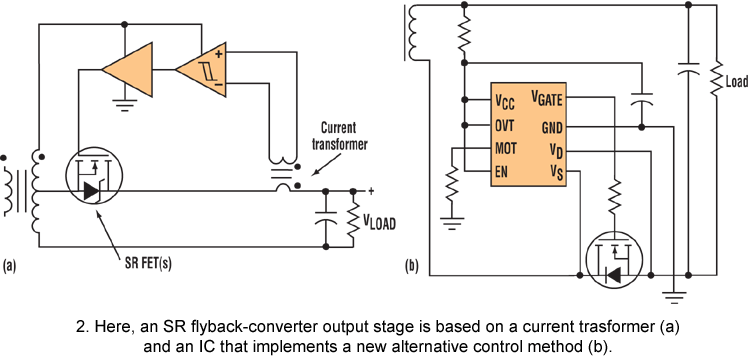
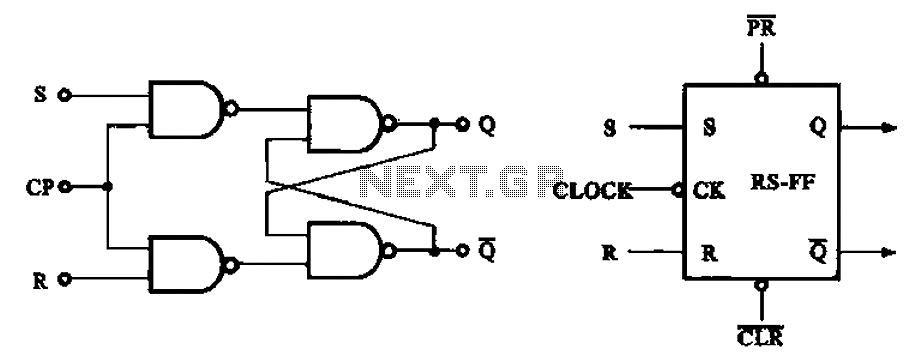
.png)
